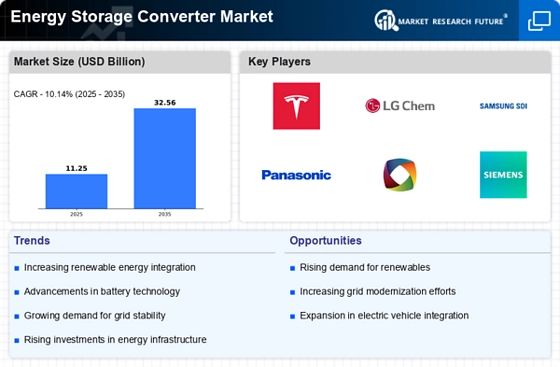Advancements in Battery Technology
Technological innovations in battery technology are significantly influencing the Energy Storage Converter Market. The development of high-capacity, long-life batteries, such as lithium-ion and solid-state batteries, enhances the efficiency and performance of energy storage systems. These advancements not only improve energy density but also reduce costs, making energy storage solutions more accessible. Market data indicates that the battery storage capacity is expected to reach over 300 GWh by 2030, reflecting a substantial increase in demand for energy storage converters that can effectively manage and convert this stored energy.
Decentralization of Energy Systems
The trend towards decentralized energy systems is reshaping the Energy Storage Converter Market. As more consumers and businesses adopt distributed energy resources, such as rooftop solar panels and small wind turbines, the need for effective energy storage solutions becomes paramount. Energy storage converters facilitate the management of energy produced at the local level, allowing for greater energy autonomy. Data indicates that the distributed energy resource market is expected to grow significantly, with projections suggesting a doubling of installed capacity by 2030. This decentralization trend is likely to drive the demand for innovative energy storage converters.
Government Incentives and Policies
Government incentives and supportive policies play a crucial role in shaping the Energy Storage Converter Market. Many governments are implementing financial incentives, tax credits, and subsidies to encourage the adoption of energy storage technologies. These initiatives aim to promote energy independence and reduce reliance on fossil fuels. For instance, various countries have set ambitious targets for energy storage deployment, with some aiming for a tenfold increase in capacity by 2030. Such regulatory frameworks create a favorable environment for the growth of energy storage converters, as they become integral to achieving these national energy goals.
Rising Demand for Renewable Energy
The increasing emphasis on renewable energy sources is a primary driver for the Energy Storage Converter Market. As nations strive to meet ambitious carbon reduction targets, the integration of renewable energy into the grid becomes essential. Energy storage converters facilitate this integration by enabling the efficient conversion and storage of energy generated from sources such as solar and wind. According to recent data, the renewable energy sector is projected to grow at a compound annual growth rate of over 8 percent through the next decade. This growth necessitates advanced energy storage solutions, thereby propelling the demand for energy storage converters.
Increased Focus on Energy Efficiency
The growing awareness of energy efficiency and sustainability is driving the Energy Storage Converter Market. Businesses and consumers alike are seeking ways to optimize energy usage and reduce costs. Energy storage converters enable users to store excess energy during low-demand periods and utilize it during peak times, thus enhancing overall energy efficiency. Market analysis suggests that energy efficiency measures could lead to a reduction in energy consumption by up to 30 percent in certain sectors. This shift towards energy-efficient solutions is likely to bolster the demand for advanced energy storage converters.

















Leave a Comment